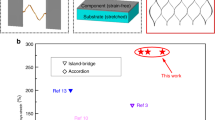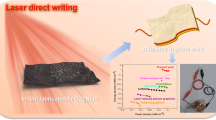Abstract
The recently emerging laser-induced graphene (LIG) technology, with one-step processing and designable features, has been widely used in the fabrication of wearable/portable electronics. Herein, by taking inspiration from kirigami, we designed a stretchable supercapacitor (SC) step by step through controlling laser induction and cutting process on the polyimide (PI) film, with the use of one single CO2 laser source. Firstly, the carbonized basic geometric units of lines were produced on PI films to investigate the processing-structure relationships. Then, the complex photothermal conversion and heat transfer progress involved in the carbonized process were simulated by a photothermal model. Both experimental and theoretical results suggested that the laser power, scan rate and focus condition have great influence on the size, shape and morphology of the carbonized lines. Finally, we optimized the parameters of laser induction and cutting process to fabricate the kirigami-inspired SCs with reliable electrochemical properties and editable mechanical flexibility, showing great potential in the field of flexible electronics.
Similar content being viewed by others
References
Kim D H, Ahn J H, Choi W M, et al. Stretchable and foldable silicon integrated circuits. Science, 2008, 320: 507–511
Chen Y, Au J, Kazlas P, et al. Flexible active-matrix electronic ink display. Nature, 2003, 423: 136
Yamada T, Hayamizu Y, Yamamoto Y, et al. A stretchable carbon nanotube strain sensor for human-motion detection. Nat Nanotech, 2011, 6: 296–301
Luo S, Hoang P T, Liu T. Direct laser writing for creating porous graphitic structures and their use for flexible and highly sensitive sensor and sensor arrays. Carbon, 2016, 96: 522–531
Sun B, McCay R N, Goswami S, et al. Gas-permeable, multifunctional on-skin electronics based on laser-induced porous graphene and sugar-templated elastomer sponges. Adv Mater, 2018, 30: 1804327
Xing D, Lu L, Teh K S, et al. Highly flexible and ultra-thin Ni-plated carbon-fabric/polycarbonate film for enhanced electromagnetic interference shielding. Carbon, 2018, 132: 32–41
Zang X, Shen C, Kao E, et al. Titanium disulfide coated carbon nanotube hybrid electrodes enable high energy density symmetric pseudocapacitors. Adv Mater, 2018, 30: 1704754
Cima M J. Next-generation wearable electronics. Nat Biotechnol, 2014, 32: 642–643
Mei X, Lu L, Xie Y, et al. An ultra-thin carbon-fabric/graphene/poly-(vinylidene fluoride) film for enhanced electromagnetic interference shielding. Nanoscale, 2019, 11: 13587–13599
Zhu J, Yang D, Yin Z, et al. Graphene and graphene-based materials for energy storage applications. Small, 2014, 10: 3480–3498
Choi W, Lahiri I, Seelaboyina R, et al. Synthesis of graphene and its applications: A review. Critical Rev Solid State Mater Sci, 2010, 35: 52–71
Sokolov D A, Rouleau C M, Geohegan D B, et al. Excimer laser reduction and patterning of graphite oxide. Carbon, 2013, 53: 81–89
Go D, Lott P, Stollenwerk J, et al. Laser carbonization of PAN-nanofiber mats with enhanced surface area and porosity. ACS Appl Mater Interfaces, 2016, 8: 28412–28417
Longo A, Verucchi R, Aversa L, et al. Graphene oxide prepared by graphene nanoplatelets and reduced by laser treatment. Nanotechnology, 2017, 28: 224002
Wan Z, Streed E W, Lobino M, et al. Laser-reduced graphene: Synthesis, properties, and applications. Adv Mater Technol, 2018, 3: 1700315
Lewis J A, Gratson G M. Direct writing in three dimensions. Mater Today, 2014, 7: 32–39
Li K, Xie Y, Liang L, et al. Wetting behavior investigation of a complex surface prepared by laser processing combined with carbon films coating. Surf Coatings Tech, 2019, 378: 124989
Zhao Y, Han Q, Cheng Z, et al. Integrated graphene systems by laser irradiation for advanced devices. Nano Today, 2017, 12: 14–30
Dubey A K, Yadava V. Laser beam machining—a review. Int J Machine Tools Manufacture, 2008, 48: 609–628
Osgood R M, Gilgen H H. Laser direct writing of materials. Annu Rev Mater Sci, 1985, 15: 549–576
Guo P, Zou B, Huang C, et al. Study on microstructure, mechanical properties and machinability of efficiently additive manufactured AISI 316L stainless steel by high-power direct laser deposition. J Mater Processing Tech, 2017, 240: 12–22
Piqué A, Auyeung R C Y, Kim H, et al. Laser 3D micro-manufacturing. J Phys D-Appl Phys, 2016, 49: 223001
Xu L, Shyu T C, Kotov N A. Origami and kirigami nanocomposites. ACS Nano, 2017, 11: 7587–7599
Zang X, Chen W, Zou X, et al. Self-assembly of large-area 2D polycrystalline transition metal carbides for hydrogen electrocatalysis. Adv Mater, 2018, 30: 1805188
Ye R, James D K, Tour J M. Laser-induced graphene: From discovery to translation. Adv Mater, 2019, 31: 1803621
Huang H C, Chung C J, Hsieh C T, et al. Laser fabrication of all-solid-state microsupercapacitors with ultrahigh energy and power based on hierarchical pore carbon. Nano Energy, 2016, 21: 90–105
Lin J, Peng Z, Liu Y, et al. Laser-induced porous graphene films from commercial polymers. Nat Commun, 2014, 5: 5714
Chyan Y, Ye R, Li Y, et al. Laser-induced graphene by multiple lasing: Toward electronics on cloth, paper, and food. ACS Nano, 2018, 12: 2176–2183
Ye R, James D K, Tour J M. Laser-induced graphene. Acc Chem Res, 2018, 51: 1609–1620
Wang W, Lu L, Xie Y, et al. A highly stretchable microsupercapacitor using laser-induced graphene/NiO/Co3O4 electrodes on a biodegradable waterborne polyurethane substrate. Adv Mater Technol, 2020, 5: 1900903
Zang X, Shen C, Chu Y, et al. Laser-induced molybdenum carbidegraphene composites for 3D foldable paper electronics. Adv Mater, 2018, 30: 1800062
Xu R, Zverev A, Hung A, et al. Kirigami-inspired, highly stretchable micro-supercapacitor patches fabricated by laser conversion and cutting. Microsyst Nanoeng, 2018, 4: 36
Wang Y, Wang Y, Zhang P, et al. Laser-induced freestanding graphene papers: A new route of scalable fabrication with tunable morphologies and properties for multifunctional devices and structures. Small, 2018, 14: 1802350
Liu H, Tang Y, Lu L, et al. Investigation on fiber laser cutting of polyacrylonitrile-based carbon fiber tow. J Mater Processing Tech, 2019, 263: 151–163
Inagaki M, Harada S, Sato T, et al. Carbonization of polyimide film “kapton”. Carbon, 1989, 27: 253–257
Duy L X, Peng Z, Li Y, et al. Laser-induced graphene fibers. Carbon, 2018, 126: 472–479
Trusovas R, Ratautas K, Račiukaitis G, et al. Graphene layer formation in pinewood by nanosecond and picosecond laser irradiation. Appl Surf Sci, 2019, 471: 154–161
Bityurin N, Malyshev A. Bulk photothermal model for laser ablation of polymers by nanosecond and subpicosecond pulses. J Appl Phys, 2002, 92: 605–613
Mazumder J, Steen W M. Heat transfer model for CW laser material processing. J Appl Phys, 1980, 51: 941–947
Bityurin N, Luk’yanchuk B S, Hong M H, et al. Models for laser ablation of polymers. Chem Rev, 2003, 103: 519–552
Arnold N, Bityurin N. Model for laser-induced thermal degradation and ablation of polymers. Appl Phys A-Mater Sci Processing, 1999, 68: 615–625
Ruan X, Wang R, Luo J, et al. Experimental and modeling study of CO2 laser writing induced polyimide carbonization process. Mater Des, 2018, 160: 1168–1177
Liu H, Tang Y, Xie Y, et al. Effect of pulsed Nd:YAG laser processing parameters on surface properties of polyimide films. Surf Coatings Tech, 2019, 361: 102–111
Koren G, Yeh J T C. Emission spectra, surface quality, and mechanism of excimer laser etching of polyimide films. Appl Phys Lett, 1984, 44: 1112–1114
Marshall W J. Two methods for measuring laser beam diameter. J Laser Appl, 2010, 22: 132–136
Zhang Z M, Lefever-Button G, Powell F R. Int J Thermophysics, 1989, 19: 905–916
Saito M, Gojo T, Kato Y, et al. Optical constants of polymer coatings in the infrared. Infrared Phys Tech, 1995, 36: 1125–1129
Venkatachalam S, Depriester M, Sahraoui A H, et al. Thermal conductivity of Kapton-derived carbon. Carbon, 2017, 114: 134–140
Foster P J, Howarth C R. Optical constants of carbons and coals in the infrared. Carbon, 1968, 6: 719–729
Clerici F, Fontana M, Bianco S, et al. In situ MoS2 decoration of laser-induced graphene as flexible supercapacitor electrodes. ACS Appl Mater Interfaces, 2016, 8: 10459–10465
Wu J B, Lin M L, Cong X, et al. Raman spectroscopy of graphene-based materials and its applications in related devices. Chem Soc Rev, 2018, 47: 1822–1873
Inagaki M, Ohta N, Hishiyama Y. Aromatic polyimides as carbon precursors. Carbon, 2013, 61: 1–21
Wang W, Lu L, Xie Y, et al. Tailoring the surface morphology and nanoparticle distribution of laser-induced graphene/Co3O4 for highperformance flexible microsupercapacitors. Appl Surf Sci, 2020, 504: 144487
Xie Y, Zhang C, He X, et al. Monolithic electrochemical cells for overall water splitting. J Power Sources, 2018, 397: 37–43
Zhang C, Xie Y, Zhang C, et al. Upgrading coal to multifunctional graphene-based materials by direct laser scribing. Carbon, 2019, 153: 585–591
Author information
Authors and Affiliations
Corresponding author
Additional information
This work was supported by the National Natural Science Foundation of China (Grant No. 51775197), the Science and Technology Planning Project of Guangdong Province (Grant No. 2018A050506007), and the Guangzhou Science and Technology Program Project (Grant No. 201704020090).
Rights and permissions
About this article
Cite this article
Wang, W., Lu, L., Xie, Y. et al. Controlling the laser induction and cutting process on polyimide films for kirigami-inspired supercapacitor applications. Sci. China Technol. Sci. 64, 651–661 (2021). https://doi.org/10.1007/s11431-019-1543-y
Received:
Accepted:
Published:
Issue Date:
DOI: https://doi.org/10.1007/s11431-019-1543-y




